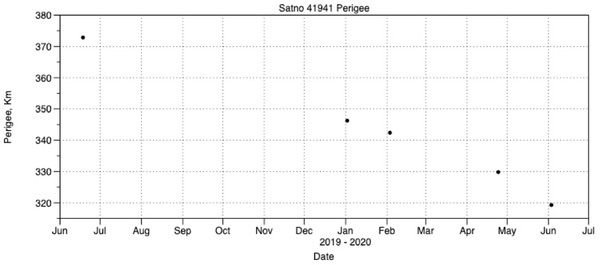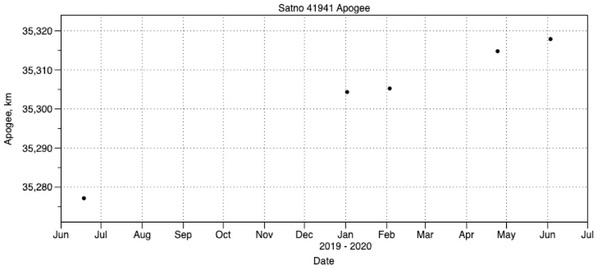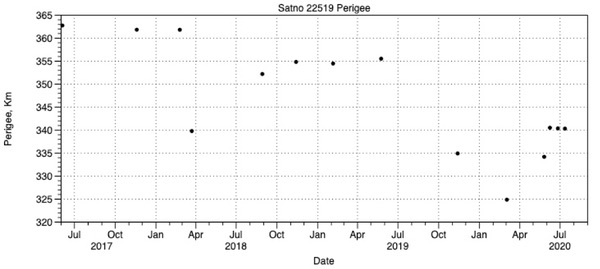
Tracking off-the-books satellites with low perigeesby Charles Phillips
|
| Those examples show that there are satellites that will reenter one day that are currently not shown in the Satellite Catalog and might not show up in the “normal” reentry prediction web pages when the time comes. |
But some satellites do not appear in the normal alerting web pages: let’s call them the “off-the-books” satellite. A good introduction to this oddity is an earlier story in The Space Review, about how some of these objects can be overlooked (see “Acknowledging some overlooked satellites”, The Space Review, June 12, 2017). As that article says, there are a number of satellites that have an entry in the Satellite Catalog but for which no orbital parameters are shown, and if one of these reenters it will not be shown in the normal alerting web pages, like one maintained by The Aerospace Corporation.
However, there is an international observer network that I am a part of that tracks many of those objects and maintains current orbital parameters for them. These people do some amazing work, though they are difficult to work with. The group, before I joined them, analyzed a reentry in Spain in 2015 and traced it back to an off-the-books Centaur upper stage that had reentered. (That effort was described in a paper published in the Journal of Space Safety Engineering.) They also connected a reentry in Mongolia to an off-the-books satellite, and later I did an analysis of one that reentered in the South Pacific (see “Why the US should notify the public of all satellite reentries”, The Space Review, January 2, 2018).
This article is somewhat of an extension that earlier one. Those examples show that there are satellites that will reenter one day that are currently not shown in the Satellite Catalog and might not show up in the “normal” reentry prediction web pages when the time comes. Since the observer group makes the orbital parameters available, one thing that is fun to do is watch some off-the-books satellites with low perigees. When you think of satellites with low perigees you wonder if they will reenter soon, although there are none that are in danger of that for now.
There are two general classes of satellites in this low perigee group: the high eccentricity objects and the retired US Naval Ocean Surveillance Satellite (NOSS) objects (and then there are a few others). The more interesting cases are the objects with high eccentricity—low perigees but higher apogee—which can be relatively light upper stages.
The lowest example is a satellite that I have been watching for months is object number 41941. This object would be very uninteresting if its orbital parameters were shown in the Satellite Catalog, as it is a very common upper stage. It was used to propel a Japanese military communications satellite (DSN-2) into geosynchronous orbit and there is no good reason that the orbital parameters are withheld. The fact that it has not been declassified, along with a number of other objects, is probably due to inadequate procedures for reviewing these objects.
| These objects are excellent examples of how the Air Force continues to withhold the orbits of objects, when that just causes them to waste effort. |
This object has a perigee of about 320 kilometers right now, which is significantly lower than, for instance, the orbit of ISS, which is at about 400 kilometers. But it does mean that, at perigee, the satellite experiences significant friction (usually called drag) from the atmosphere so it loses energy every time it goes through perigee. Object 41941 loses about 50 kilometers of perigee height every year, so it will likely reenter in about four years. As perigee decreases, the atmospheric drag increases and the perigee will decrease faster. With an inclination of 20 degrees it may impact the ground, unlike many transfer orbit stages that have higher inclinations and tend to reenter over the southern oceans.
This plot below shows calculated perigee over time. Each point comes from an updated orbit, and the update comes when observers track the object and submit observations.
 |
An odd thing about this satellite is that its apogee is increasing. Many of these low perigee objects show a near-sinusoidal periodicity in perigee; that is, it tends to increase and decrease over time. This apparently is mostly due to lunar effects on the orbits: that decreases eccentricity and so the perigee increases. But possibly, the effect on this object is for its apogee to increase.
 |
This object is not tracked often so we don’t have very many updates and therefore points to plot, but it does show a very consistent trend.
The other higher eccentricity object that is interesting right now is 22519, an upper stage for USA 89. This stage launched USA 89 into a high eccentricity orbit on STS-53, a Department of Defense mission of the Space Shuttle. So, this is almost certainly an Inertial Upper Stage, the upper stage used on most DoD shuttle missions. I worked on several IUS missions when I was in the Air Force and so that makes this object even more interesting. There are several debris pieces cataloged from 22519, so it shed pieces at some point. The perigee for this object is a respectable 340 kilometers and apogee is approximately 6,420 kilometers, so it experiences atmospheric drag only at perigee. Inclination is 56 degrees so it overflies many landmasses: when it reenters it might hit land.
Its perigee decreases by only about 10 kilometers per year, so it will be in space for a long time; it must be a dense object. We have more updates and points for this object than more many others but I did eliminate two outlier points.
 |
These satellites are boring at best and so the observer network doesn't track them very often; any analysis has to be done with few data points.
There are other objects with higher perigees but which lose perigee altitude faster, so 22519 will be passed by others long before it decays. The next two higher satellites are 90109 (an unknown that is tracked by the observer community) and 40978 (a Centaur upper stage) but their perigees are above 400 and 500 kilometers respectively.
These objects are excellent examples of how the Air Force continues to withhold the orbits of objects, when that just causes them to waste effort (see “Time for common sense with the satellite catalog”, The Space Review April 10, 2017). With any luck (hint, hint) the Air Force will soon realize that these objects reveal nothing with their orbit and will declassify them. Then they will be shown on the normal reentry monitoring pages.
The NOSS orbits were publicly available until June of 1983 and then someone decided to remove them from public visibility. The retired NOSS objects have low perigees but their decay rate is very slow, certainly due to the fact that they are dense. With perigees of more than 300 kilometers but a higher apogee of well over 1000 kilometers, their perigees decrease slowly. Their apogees are out of the atmosphere but since they are lower they spend more time losing energy to atmospheric drag.
The lowest of this group, with a perigee of about 330 kilometers, is object 11720. It is a NOSS payload and so its perigee only loses about ten kilometers per year. Objects 16591 and 14690 (for example) are in very similar situations.
| The US should be reviewing the off-the-books list and releasing orbital information on those that are no longer worth keeping secret. |
When these retired NOSS satellites get closer to reentry, hopefully the US will declassify their orbital parameters. These are almost certainly retired satellites and releasing their orbits will not reveal anything. We also now have a “civilian” version of the NOSS, developed by a company called HawkEye 360, and perhaps the Navy will retire their system and just buy the same information from that company.
There are other off-the-books satellites with perigees below 400 kilometers. These are almost certainly intelligence gathering satellites that have propulsion to maintain their orbits. After their missions are over they are commonly deorbited. A good example of this group is object 42689, USA 276, a satellite with an unusual inclination of 50 degrees. This apparently is the replacement for USA 193, the satellite that failed after launch and was destroyed by a missile launch to prevent its load of hydrazine from reaching the ground.
The US should be reviewing the off-the-books list and releasing orbital information on those that are no longer worth keeping secret. They have released data on a number of objects but they could review their processes and catch some objects like 41941.
This article could not have been written without help from two colleagues. Mike Marston wrote the critical piece of software that was used to sort and group satellites; he is far better at writing C code than I am. The plots were produced with a very well designed application, DataGraph, from Visual Data Tools. Pamela Schultz helped me get the data inserted correctly. Most people make plots using another application but DataGraph is far faster and more intuitive.
Note: we are temporarily moderating all comments submitted to deal with a surge in spam.